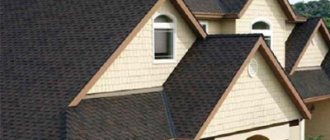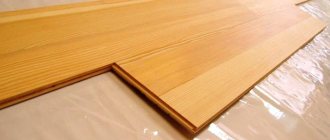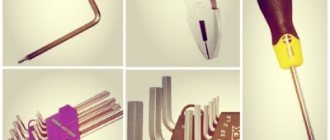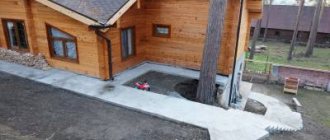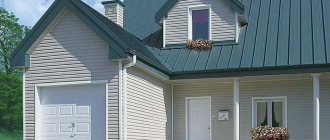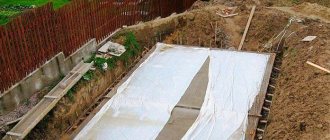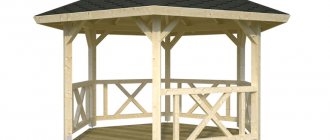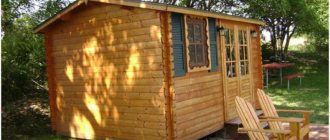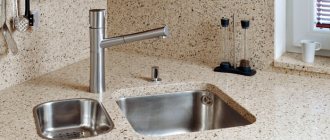SHARE ON SOCIAL NETWORKS
FacebookTwitterOkGoogle+PinterestVk
Metal tiles are a material that is used for roofing along with such popular materials as slate, bituminous shingles and galvanized sheet. Excellent technical characteristics make it an excellent option for any home. And although they usually prefer to invite professionals to carry out this kind of work, let’s look at how to install metal tiles yourself: step-by-step instructions and some recommendations from specialists.
The use of metal tiles is one of the most popular roof finishing options.
What are the advantages of installing a metal roof?
A tile roof, especially if it is made of metal, is one of the best options for decorating a home. Experts and users themselves note many positive aspects of using this material, including:
- light weight (4-6 kg/m²), which ensures very little load on the roof;
Metal roofing is distinguished by its affordable price, long service life and expressive appearance.
- simple installation procedure and ease of repair work;
- wide range of color solutions;
- the material is environmentally friendly and does not contain any harmful components;
- the coating is equipped with stiffening ribs, which makes it very durable. Provided that all installation recommendations are followed, the surface can withstand a load of 200 kg/m², even if 0.5 mm thick sheets were used;
- the material is extremely temperature resistant. It is not afraid of any changes, and the rate of thermal expansion is minimal.
There is practically no need to talk about the disadvantages of metal tiles, with the possible exception of increased noise levels on days when it rains. But this can also be dealt with if you first lay a layer of glass wool.
The use of metal tiles as a roof for the roof of a private house is convenient due to its simple installation technique and high speed of work
Criteria for choosing a material for a metal roof: photo examples
Before you begin considering the installation process of this roofing material, you need to decide exactly how the material should be used.
Looking at photos of roofs on which metal tiles look attractive is far from the best method in this case, since in the selection process you need to pay attention to the list of additional elements, as well as the markings provided by the manufacturer. Let's look at what the buyer needs to know.
First of all, you need to pay attention to the presence in the price list of such additional elements as:
- different types of skates: simple, figured and with aerators;
- special passage units for installing pipes, hatches, ventilation, antennas, as well as lighting windows;
- elements designed to ensure the safety of surface maintenance - walking bridges, ladders, snow guards;
- internal and external valleys;
- other necessary elements are wall profiles, pediments, metal tile eaves, the installation of which is an obligatory part of the roofing arrangement.
Thanks to a wide selection of metal tile colors, you can choose the most aesthetic option for a private home
Important! The presence of all of the listed elements among the seller’s offers is an indicator of the level of the company that produces metal tiles, which may also indicate the quality of the products themselves.
In addition, it is worth paying attention to studying the markings, which must be present on each certified material. Typically, production indicates all the characteristics of the material itself, as well as the level of quality of the anti-corrosion coating that is applied on top of the sheet.
So, here is what information you can glean by reading the information provided on the back of the metal tile sheet:
- presence of polymers;
- how much zinc is per 1 m² of sheet;
- production date and warranty period for the use of the material;
- manufacturer's name;
- sheet thickness.
When purchasing metal tiles, it is important to pay attention to the manufacturer’s quality certificates
During the visual inspection, you need to pay attention to the integrity of the protective layer, both on the front and back sides of the sheet, as well as the presence of all required markings.
Important! If we are talking about material purchased from a large manufacturer, then the marking will also contain information about the grade of steel used.
Installation of metal tiles: step-by-step instructions for independent work
Considering the fact that the price of installing metal tiles has never been low, many people prefer to try to do everything they need on their own. Although initially it is worth familiarizing yourself with how much professional installation of metal tiles costs. The price of work per m2 starts from 250 rubles and can increase depending on the complexity.
The process of installing a metal tile roof, the technology of which will be discussed below, consists of several stages, each of which has its own significance and must be carried out properly.
Metal tiles are an environmentally friendly material and do not contain harmful components.
Laying metal tiles: preparatory stage and calculations
The first thing that needs to be done if a decision has been made to independently carry out the procedure for laying metal tiles on the roof surface is to carry out preliminary calculations. This is necessary in order to determine how much of what materials will be required and, accordingly, avoid unnecessary costs.
Let's start by clarifying some basic concepts so that in the future the question of how exactly a metal tile roof is constructed does not arise. If you look at a roof that has already been covered with this material, you can see that it consists of rows that run across the slope and waves. The distance from one row to another is called a step.
There is such a thing as a “model”. This name refers to sheets of metal tiles, the pitch of which is 35 cm, and the number of waves is 6. Sheets of modules 1, 3, 6 and 10 can be found on sale.
Roofing pie installation diagram: 1. Rafter system, 2. Counter battens, 3. Waterproofing film, 4. Vertical sheathing bars, 5. Horizontal sheathing starter beam, 6. Horizontal sheathing bars, 7. Additional sheathing, 8. Wind board, 9. Bracket for gutter, 10. Eaves strip, 11. Metal tile, 12. Roof ridge. 13. Ridge seal, 14. Dormer window, 15. Thermal insulation material, 16. Vapor barrier material, 17. Attic lining.
Helpful advice! In addition to purchasing sheets of standard sizes, you can consider the option of individually manufacturing metal tiles to order. Of course, it will cost noticeably more, but this way you can get exactly the material that is right for you. The main thing to remember is that the length of one sheet should not be less than 45 cm or more than 7 m.
In the process of choosing the appropriate sheet size, you need to be guided by the fact that after installation the joints and waves converge in such a way as to form a single coating along the entire length of the slope. It is quite easy to calculate the amount of material, taking into account the length of the roof and sheets.
When purchasing metal tiles, it is important to pay attention to some additional elements that are included in the kit and allow for proper installation. This includes steel strips 2 m long, as well as steel sheets 200x125 cm, which must have the same color as the tiles.
In the process of purchasing metal tiles, you need to make sure that these auxiliary elements are available in sufficient quantity and meet all requirements. For example, the standard bar inclination level is 30 degrees. Although other options are possible at the request of buyers - from 11 to 70 degrees.
Before choosing metal tiles as a roof, you should pay attention to the angle of the roof.
Important! 11 degrees is the minimum slope at which metal tiles can be installed.
Materials and tools for laying metal tiles with your own hands
In order to install metal tiles with your own hands, you need to take care in advance of having some tools and materials that will allow you to carry out all the work as simply and efficiently as possible:
- screwdriver;
- electric drill;
- scissors for cutting metal;
- yardstick;
- hammer;
- marker;
- mounting tape.
It is also worth taking care of the presence of a stepladder and means intended for personal protection of the face and hands (goggles, gloves).
Fastening the metal tiles to the sheathing is carried out using self-tapping screws and a screwdriver
As for the consumables that will be required to prepare the base and fasten the metal tiles, this list includes: waterproofing material, roofing strips, tiles, as well as an aeroroller, strips for the ridge and ends, a guide board and 2.5x10 cm boards. itself, you will also need fastening elements - self-tapping screws and special sealing washers for them.
Helpful advice! To give the coating an attractive appearance, decorative overlays should be used.
Necessary tool for construction
When doing the work yourself, you should prepare the following tool in advance:
- Bulgarian,
- electric drill,
- screwdriver,
- metal scissors and film cutting scissors,
- hacksaw,
- metal hacksaw,
- hammer,
- chisel,
- file,
- axe,
- construction knife,
- roulette,
- metal ruler,
- square,
- plumb line,
- building level,
- marker,
- construction or furniture stapler,
- paint brushes and roller.
How to attach metal tiles: stages of preparatory work
The low weight of metal tiles allows for a minimum amount of preparatory work to be carried out before proceeding to installation. Nevertheless, it is still necessary to prepare a suitable foundation. Since there is no need for a reinforced base, a regular wooden sheathing made from slats is quite suitable.
In order to cover the roof with metal tiles, you first need to install the sheathing
The procedure is extremely simple - based on the pitch of the selected metal tile, slats are placed on the surface. It is important to maintain a uniform distance so that during the process of attaching the roofing material you do not have to screw screws into the void. Another important factor to consider when installing the sheathing is the location of the windows. It is highly undesirable to place rafters directly above the windows.
Related article:
Dimensions of metal roofing sheets: price and selection parameters, installation of material
Features of material models, types of polymer coating. Subtleties of installing a metal roof.
Thermal insulation during installation of a metal roof
When it comes to installing a roof made of metal tiles, the thermal insulation material is designed to solve two problems at once - to reduce heat loss and also to reduce the noise level produced by raindrops hitting the surface. To do this, a vapor barrier material is first laid on the rafters, and then a layer of thermal insulation. It is important that the thickness of the layer does not exceed 25 cm. An antioxidant film is attached to the top, fixing it with wooden blocks directly to the rafters.
Important! In order to ensure that precipitation flows into the drain, the material must be fixed with a small allowance (about 2 cm). Due to such a small sagging, there will be no problems with water drainage.
This “pie” is the most effective roof thermal insulation system that metal tile installation technology allows. As for the choice of thermal insulation material, there are several options that depend on cost, quality and manufacturer.
Scheme of a roofing pie for metal tiles
Mounting methods
Fastening roof components.
The most important thing is that the roof must meet the requirements of reliability and strength . Therefore, it is not enough to correctly apply the installation technique; it is equally important to ensure that the joints of the structural elements are fastened. Characteristic points that ensure reliability are the ridge on the roof, the connection of the rafter legs and the mauerlat (and itself to the outer walls), racks and floor beams, layered rafters with the upper and lower purlins. Durability, the ability to withstand snow and wind loads, and the safe operation of the roof directly depend on the quality of fastening components.
Installation of the Mauerlat is carried out with anchors concreted into the brickwork or wooden samples and studs. The fastening step is equal to the step of the rafter legs. The rafters are secured to the outer wall one at a time with metal ruffs and wire twists. The ruff should fit into the masonry at least 4 rows lower. The Mauerlat and rafters are connected by notches, thrust bars, and staples. Installation of vertical and horizontal connections is made with nails. The ridge fastening is done with brackets, wooden plates and studs.
Installation of a metal tile roof: basic operating rules
Before you begin work directly related to laying metal tiles, you need to familiarize yourself with some rules and concepts that will allow you to avoid common mistakes and do everything necessary with the highest possible quality:
- There are two ways to lay sheets of metal tiles: from right to left and from left to right. In the first case, each subsequent sheet must be laid overlapping the previous one, and in the second, the previous sheet must be overlapped.
- There is no need to attach each sheet completely at once. Before screwing the metal tiles, it is best to lay four sheets and lightly grab them with fasteners so that they hold. Then you need to make sure that they are located as needed and, if necessary, trim them. For final fastening, use one self-tapping screw, which passes through all the sheets.
- The service life of the entire roof greatly depends on the quality of the fasteners used. Therefore, due attention should be paid to the choice of self-tapping screws. It is important that they are galvanized and must have special seals on the heads that can hermetically fill the holes when the self-tapping screw is completely screwed into the hole.
- In those places where several sheets were fastened with one fastener at once, one way or another, a seal will appear. In order to smooth it, it is necessary to cut off part of the corner, or you can straighten the capillary ditch, which is located under the stamping line.
Finishing work using metal tiles must be carried out in accordance with the rules for installing roofing tiles
Scheme of fastening metal tiles and other necessary elements
Certain rules also exist for the installation of other mandatory elements, without which no roof can do. Here are some recommendations regarding the installation scheme of metal tiles and other elements:
- the end strips must be fixed with an overlap, which should be about 2 cm. In this case, the size of the wave must be adjusted in accordance with the width of the slope. Otherwise, you may encounter the fact that the ridge will fit onto the pediment;
- for the cornice strip it is also necessary to have an overlap of 10 cm on the bottom bar of the sheathing, to which it is attached with nails;
- It is imperative to lay an additional layer of sealing material between the metal tile sheet and the roofing strip;
- for the arrangement of all elements located below the ridge (pipes and windows), sheets with one module are used. Typically, 2 pieces are required for each structural element;
- if the roof slope is sloping, then it is necessary to additionally install an aerial roller between the ridge strip and the material itself. This will prevent precipitation from penetrating under the ridge;
Scheme of fastening sheets of metal tiles
- The ridge must be fixed to the planks, which are located at the end of the entire structure. In this case, calculations must be carried out taking into account the required protrusion, which is 2-3 cm. Moreover, if you have to deal with a flat ridge, then the fastening is done with an overlap, and for semicircular elements according to the profile lines;
- It is necessary to study in advance the specifics of installing a drip line under metal tiles, and strictly follow all instructions.
Helpful advice! If you have to work with a roof whose inclination angle is more than 45 degrees, then it is worth carrying out calculations in advance that will allow you to determine whether it is possible to install a specific model of ridge strip in this case. This must be done, because otherwise, you may even need to completely replace the entire roofing covering.
It is also worth paying attention to the fact that, if necessary, the ridge strip can be slightly adjusted. That is, it can not be bent or straightened in order to ensure the most accurate repetition of the angle of the roof. You can learn more about such subtleties from the video instructions for installing metal tiles.
Scheme of fastening sheets of metal tiles and placement of screws
Installation of ventilation and passage elements
The main passage element is the abutment strip . It covers the joint between the roofing material and any structure located above the roof. To install the strip, a groove is formed in the exiting structure.
There is a seal under the strip. The joint is sealed with sealant. If it is impossible to make a groove, then the abutment strip is made in the shape of a corner. Its vertical wall fits tightly to the surface of the structure and is sealed.
Ventilation deserves special attention . There are special holes in the ridge strip for air to escape. They must be connected to the ventilation gaps of the “roofing pie”. In addition, ventilation outlets are required in each span of rafters.
For such exits, holes are drilled in the metal tiles. One exit is designed for an area of 60 sq.m. Special ventilation elements are installed in these openings.
Installation of a valley when roofing with metal tiles
Another extremely important element, the installation rules of which cannot be neglected, is the valley. For each such element, an additional board must be attached. In this case, fastening must begin from the bottom, gradually moving upward and not forgetting about the need for overlap (in this case, 25-30 cm). Below the level of the cornice, be sure to cut off the bottom strip. Then follows the flanging, under which, as well as under the ridge, a seal is laid.
There remains a gap between the sheets and the axis, about 8-10 cm in size. Then, at a distance of approximately 1.5 cm from the stamping line, screws are screwed into the cut sheets. In this case, the fastening should be located 25 cm from the valley axis. If you follow this technology, then eventually the sheet, at the fastening point, will converge with the board on which the valley is located.
As for the installation of the valley below, it must begin before laying the roofing material. This is important to ensure that water flows directly into the additional element in the future.
Scheme for installing a valley when roofing with metal tiles
Important! All errors in the process of calculations and measurements can lead to the appearance of gaps on the surface, and when heavy precipitation begins, the roof will most likely leak.
In order to cover those places where the cut sheets are visible, special decorative overlays are used. When installing them, you also need to remember a few simple rules:
- installation must be done from the bottom up;
- a sealant between the lining and the tile is not needed;
- the overlays must be overlapped by at least 10 cm;
- fastening elements (in this case self-tapping screws) should not cause damage to the valley.
Very often you have to deal with situations where the beginning and end of the valleys are located directly on the roof slope. As an example, we can consider the case when a dormer window is installed. In such a situation, it is necessary to lay a separate board, and for the window itself, a hole is made in the metal tile sheet. The cornice cut is covered with a plank. And sealing material must be laid along the walls.
Scheme for calculating endowa when roofing with metal tiles
Video description
The following video will allow you to better understand how to cover a roof with metal tiles.
The assembly process includes several stages:
- is attached to the edge of the cornice , which is 15 cm thicker than all the others. The next one is installed 50 mm closer than all subsequent ones.
- Bars with a cross section of 50 mm are placed on the rafter legs , which will be used as an internal counter-lattice. This add-on is necessary to form a ventilation vent.
- Waterproofing is installed on the internal counter-lattice , fixation is carried out using a stapler. The film is not stretched tightly; a certain amount of slack should be left. The individual panels are overlapped with an overlap of 15 cm.
- Boards are placed on top of the waterproofing , which make up the external counter-lattice.
- After the reinforced elements are installed on all the cornices, the remaining boards are attached .
- The end strip is attached to the height of the tile wave so that it rises above the general level of the sheathing.
The sheathing can be regular or solid. The first option is suitable in most cases, while a complete covering of boards with a gap of 15 mm is used with heavy sheathing of high thickness.
How to lay metal tiles on a roof with a triangular or trapezoidal slope
If there is a need to cover a triangular or trapezoidal roof with metal tiles, then the installation of two additional bars will be required. They are installed along the fold line of the roof on both sides of the “ridge”. After this, the cornice board is mounted and the assembly of the sheathing begins. The sheathing pitch for metal tiles in this case is calculated in the same way as with the standard scheme. Then the cornice system is installed. They begin to lay the metal tiles only after all these procedures have been carried out, orienting and aligning the first sheet along the eaves strip.
Important! The distance between the corner sheets that were trimmed and installed near the “ridge” should not exceed 10 cm.
In order to install the ridge assemblies, you need to align the ridge strips relative to the angle of the “ridge”. If you use a straight ridge, it must be cut according to the existing corners, and for a semicircular ridge special plugs are provided. Moreover, it is best to use plastic models.
Ridge installation diagram for roofs with a triangular or trapezoidal slope
The ridge strip must be located strictly along the axis of the “ridge”. This is not too difficult a task if the slope angles are the same. If they have different sizes, then the task becomes significantly more complicated. Bright polyurethane foam is used as an auxiliary material, which allows you to determine the quality of the connection to the slopes.
Installation instructions for metal tiles "Monterrey"
A separate type of metal tile that is undoubtedly worthy of attention is Monterrey. This option is very popular due to some exceptional characteristics:
- extremely high level of material resistance to both ultraviolet radiation and other external factors, such as moisture and temperature;
- due to the layer of polymer applied to the surface of the tile, it does not lose its appearance throughout its entire service life;
- the material is extremely durable and hard, so it can withstand heavy loads;
- multilayer structure prevents corrosion;
- due to its low weight (one square meter of material weighs no more than 5 kg), the load on the rafter system is significantly reduced;
- using this option is a great savings, since there is no need to take a large step between fasteners. Initially, the installation instructions for Monterrey metal tiles provide for 35-centimeter steps.
Monterrey metal tiles are a fairly durable material due to the presence of stiffening ribs
This material has only two disadvantages - a large amount of residue after installation, as well as the need for high-quality sound insulation.
As for the features that you need to know about before laying Montrerey metal tiles, the following aspects play a role here:
- For different models of this material, it is necessary to prepare different lathing. So, for Standard or Super metal tiles, a step of 35 cm will be enough, but for Lux or Maxi, the step should be 40 cm;
- in the most difficult places of the roof (usually these are the internal corners, as well as the place where the chimney outlet is located), you need to make a continuous sheathing;
- on the junction strips, for the chimney exit, you need to install internal aprons;
- the installation instructions for Monterrey metal tiles do not provide for the use of material whose length is more than 4 m;
- Before installing the material, it is necessary to remove the protective coating, since this may be impossible to do in the future.
When installing Monterrey metal tiles, it is necessary to install high-quality sound insulation
It is strictly forbidden to cut the sheet in the transverse direction, as this may lead to the profile becoming wrinkled. Also, under no circumstances should you use a grinder or other tools with abrasive wheels for this purpose.
Interesting! Cascade metal tiles also look great, the installation instructions for which are not too different from all the others. But the appearance of such a roof is considered more aesthetic and original.
Details
Installation Ladder to the roof
Metal tiles are not suitable for any roof. The roof must have a slope of at least 11 degrees.
It is important to remember that when installing metal tiles, it is necessary to use rubber pads under the self-tapping screws. This is a technological requirement.
Metal tiles require special handling. Working with it begins with laying out the material from the packaging. This must be done with gloves. It is generally better to work with metal tiles while wearing gloves. The sheets are lifted onto the roof using a special system of guide boards.
wardrobe in the wall in Khrushchev
How to properly care for a metal roof covering
After studying the step-by-step instructions for installing metal siding, you can carry out its high-quality installation. But in order for the material to last for many years, you need to know how to care for it.
When cleaning a metal tile roof, it is important not to damage the top layer, which consists of a polymer material
The top layer of metal tiles is a polymer material that is designed to protect against corrosive processes. But as a result of constant exposure to external factors: precipitation, ultraviolet rays, as well as dust and dirt, this layer may begin to deteriorate, which will lead to the need to replace the coating. In order to avoid this phenomenon and extend the service life of the roof, it is necessary to regularly carry out the following procedures:
- remove dirt, dust and dry leaves from the surface using a damp fluffy brush;
- If we are talking about eliminating more complex stains, then it is permissible to use cleaning agents, but only those intended for polymer surfaces. The use of aggressive chemicals is strictly prohibited, as they destroy the protective layer and render the material unusable;
- cleaning of gutters is carried out using a stream of water, which should be directed from the ridge to the eaves;
- It is possible and necessary to clear snow, but this should only be done using tools that are not capable of causing damage to the delicate coating.
Provided that these simple but extremely important rules are followed, metal roofing can serve as a roofing material for about 50 years.
If a metal tile roof is damaged, it is important to carry out repairs immediately to prevent destruction of the lower layers of the roofing pie
Rafter system: construction technology
The design of a rafter roof, the slopes of which consist of several planes, is called a broken line. The arrangement of the supporting system itself depends on the number of inclined surfaces and kinks in lines. But the main elements of each of them are standard - these are the mauerlat, rafters, beams, racks, struts and tie-downs. Depending on the structural design, there may be ties, hanging rafters, vertical and horizontal braces. It should be noted that metal tiles can be laid on a roof with a slope of at least 15°. Otherwise, snow “bags” may form in winter, and rain may flow in in summer.
Metal tiles can be laid on a roof with a slope of at least 15°.
The installation of a pitched roof is carried out in the following technological sequence:
It is very convenient to erect a sloping roof using a frame scheme, so even a non-specialist can handle this technology.
Common mistakes when installing a metal tile roof with your own hands
Inexperienced craftsmen often make mistakes, which can lead to the fact that the work will have to be partially, and sometimes completely, redone. Such carelessness can lead to additional expenses for the purchase of materials and consumables, so it is better to familiarize yourself with common mistakes in advance in order to prevent them:
- installation of metal tiles should be carried out exclusively in shoes with soft soles that cannot damage or scratch the coating;
- It is strictly forbidden to step on the crest of a wave, as this may cause deformation;
- Moreover, it is generally not recommended to step on the sheets with a full foot;
- when moving along the surface of the material, the leg should be placed parallel, and not perpendicular to the slope;
- You can only handle the material while wearing gloves.
Taking these simple rules into account, as well as acting in accordance with the technology for laying metal tiles, you can make a beautiful and reliable roof yourself.
Due to its light weight, metal tiles provide very little load on the roof and foundation of the building
Additional Information
To carry out work on installing a metal tile roof, you will need the following tools:
Installation of covering sheets begins from the end of the roof.
For cutting roofing sheets use:
It is necessary to ensure that the metal tiles are cleared of metal filings and shavings. Otherwise they will rust and damage the coating. The use of an abrasive wheel is strictly prohibited.
Metal tiles are a type of coating that requires careful handling. You need to move along the surface in soft shoes, stepping into the trough of the wave. To prevent rotting, damage by bugs and increase resistance to fire, all wooden elements on the roof must be treated with fire-resistant materials. Application can be done either by spray or by brush. Processing technology, quantity and consumption vary depending on the composition. It will be necessary to dismantle metal tiles on a sloping roof only if the frame itself becomes unusable. Therefore, careful care, periodic inspection and timely treatment of wooden elements will contribute to the longevity of the roof.
Source
Installation of snow guards on metal tiles: instructions and their varieties
A high level of safety is one of the main requirements for roofing made of any material, including metal tiles. For this purpose, special structures are used, which are called snow retainers. And the main goal is to ensure safe snow removal from the roof and prevent possible dangerous situations. In addition, they help maintain the original shape of the structure and prevent it from deforming under the weight of icy snow. And considering that its weight in some cases can exceed the weight of the roof itself, this problem is quite relevant.
Important! The issue of distributing the load that snow exerts on the roof surface should be thought out at the stage of laying the foundation. This factor must be taken into account in the calculations.
It is almost impossible to predict exactly how snow will be distributed on the roof surface. This depends on many factors, including the angle of the roof, wind direction, etc. Therefore, in order to make calculations, a special formula is used:
Q = G×s
In this case, Q is the load exerted by the snow, G is the mass of snow on the flat surface of the roof, which can be found from a special table, and S is the correction factor, which depends on the angle of the roof: > 25° - 1, if 25- 60° - 0.7. If the degree of inclination is more than 60, then this is not taken into account, since in this case precipitation will definitely not linger on the surface.
An important step when finishing a roof using metal tiles is the installation of all additional elements that not only protect the coating, but also allow you to hide unsightly joints and edges
In order to determine the G index, you need to refer to a special table that provides information regarding snow cover for each region of the country.
Installation of tubular snow guards on metal tiles: installation rules
As a rule, a pipe is used as a basis for snow retention, which is laid along the roof. In the case of using metal tiles as a roofing material, fixation is made in the places where the roof and load-bearing wall connect.
It is strictly forbidden to fix these elements on the eaves strip for metal tiles, as this may lead to the destruction of the entire system. Moreover, if you have to deal with a slope whose length is quite large, then the installation of snow retainers on metal tiles must be done in several rows at once to ensure a more reliable fixation.
The process of installing tubular snow guards on metal tiles
The tubes themselves are mounted on the roof either end-to-end or in a checkerboard pattern. Special attention should be paid to installing such a system if the house has an attic. In this case, the installation must be carried out in such a way that a snow guard is located above each window opening. As for the distance from the edge of the roof to the elements, 40-50 cm is quite enough.
Lattice snow guards for metal roofing: how to attach correctly
Lattice snow retainers are considered the most effective, so those users who are interested in the quality of the installed systems preferentially choose this option. There are two types of such structures - ordinary and “royal”, although it is worth recognizing that there is not much difference between them, with the exception of the supports and the complexity of the lattice.
The high level of efficiency and safety of this type of snow retainer is due to their considerable height, due to which they may not be useful not only in winter when it comes to retaining snow, but also in summer. After all, it is during the warm season that all kinds of repair work are most often carried out.
Lattice snow retainers are considered one of the best options for metal roofing
Corner snow retainers for metal tiles
Corner snow guards are thin steel sheets that are coated with a polymer coating that protects them from corrosion. This is one of the most budget-friendly options, which at the same time allows you to effectively prevent snow from rolling off the roof. It is very easy to choose a model that will suit your existing metal tiles, since the range of color options is extremely large.
To fix the corner snow guards on the roof of a metal roof, screws and ordinary metal corners are used. Fastening is carried out on the upper wave of the sheet.
These are not all design options that can be used to prevent snow from rolling off the roof. Metal tiles are perfectly combined with many models and varieties of these elements, so there will definitely not be any problems with selection and fixation.
An example of the location of corner snow guards on a roof covered with metal tiles
Installation of a roof window in metal tiles
It is believed that installing roof windows is not a task for beginners, and it is best to contact specialists who have adequate experience in this field. But this does not mean that it is impossible to do it yourself, especially if you use step-by-step instructions for dummies. The installation of metal tiles and the installation of the window itself in this case may well proceed without any problems.
First of all, it is worth paying attention to the fact that the maximum possible width of such a window should be 80-120 mm less than the opening between the rafters. In cases where the rafter pitch is very small, two small windows are installed in adjacent niches.
The installation of the window is carried out after the roofing “pie” is completely made, then you need to install the mounting beam, for which I use the same boards as for the rafter system. Then the frame is installed and the sashes are installed. It is very important to take care of high-quality waterproofing so that in the future the window does not become a source of precipitation entering the house.
Installation of a roof window is carried out after laying all layers of the roofing pie
Of course, you have to make some changes to the process of installing the sheathing under the metal tiles, and pay special attention to the issue of installing the ridge of the metal tiles if a roof window is planned. But all these difficulties are more than justified by the excellent result that awaits the owners as a result.
Video description
This video shows cutting metal shingles with a hand saw:
Additional boards are also added near the ridge and in the valleys. To determine the best option, before laying metal tiles on the roof, you should check the geometry of the slope and measure the exact weight of the sheathing.
Features of working with lathing
The laying step of the load-bearing sheathing boards directly depends on the model of metal tiles. For example, for a Monterrey-type coating it is 350 mm. If the master does not have such information, the planks are positioned so that they fall on the lower point of the wave where the fastening will be carried out.
Particular attention is paid to complex roof elements, such as internal corners, chimney outlets and other elements. In such places, a continuous sheathing is installed with a gap between the boards no higher than 5 mm. You will also need to install internal valleys and aprons.
We must not forget about antiseptic treatment. Each board and beam is treated on all sides with a protective aerosol that prevents the penetration of harmful microorganisms such as mold and mildew. They also protect the tree from insects. In order to comply with fire safety standards, the wood is additionally treated with fire retardants.
